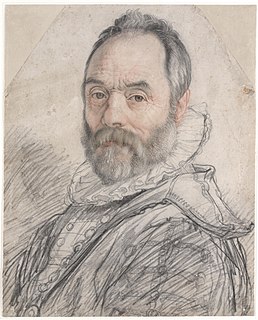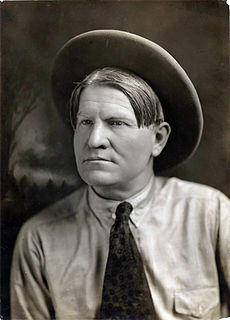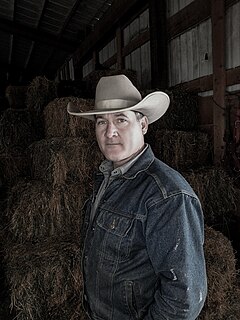Related Research Articles

Sculpture is the branch of the visual arts that operates in three dimensions. It is one of the plastic arts. Durable sculptural processes originally used carving and modelling, in stone, metal, ceramics, wood and other materials but, since Modernism, there has been an almost complete freedom of materials and process. A wide variety of materials may be worked by removal such as carving, assembled by welding or modelling, or moulded or cast.

Lee Oscar Lawrie was one of the United States' foremost architectural sculptors and a key figure in the American art scene preceding World War II. Over his long career of more than 300 commissions Lawrie's style evolved through Modern Gothic, to Beaux-Arts, Classicism, and, finally, into Moderne or Art Deco.

Giambologna — — was a Flemish sculptor based in Italy, celebrated for his marble and bronze statuary in a late Renaissance or Mannerist style.

Charles Marion Russell, also known as C. M. Russell, Charlie Russell, and "Kid" Russell, was an American artist of the American Old West. He created more than 2,000 paintings of cowboys, Native Americans, and landscapes set in the western United States and in Alberta, Canada, in addition to bronze sculptures. He is known as "the cowboy artist" and was also a storyteller and author. He became an advocate for Native Americans in the west, supporting the bid by landless Chippewa to have a reservation established for them in Montana. In 1916, Congress passed legislation to create the Rocky Boy Reservation.

Moses Jacob Ezekiel, also known as Moses "Ritter von" Ezekiel, was an American sculptor who lived and worked in Rome for the majority of his career. Ezekiel was "the first American-born Jewish artist to receive international acclaim."

Guillaume Coustou the Elder was a French sculptor of the Baroque and Style Louis XIV. He was a royal sculptor for Louis XIV and Louis XV and became Director of the Royal Academy of Painting and Sculpture in 1735. He is best known for his monumental statues of horses made for the Chateau of Marly, whose replicas now stand in the Place de la Concorde in Paris.

Albert Stewart was an American sculptor.

Charles Allan Grafly, Jr. was an American sculptor, and teacher. Instructor of Sculpture at the Pennsylvania Academy of the Fine Arts for 37 years, his students included Paul Manship, Albin Polasek, and Walker Hancock.

Solon Hannibal de la Mothe Borglum was an American sculptor. He is most noted for his depiction of frontier life, and especially his experience with cowboys and native Americans.
Millard Owen Sheets was an American artist, teacher, and architectural designer. He was one of the earliest of the California Scene Painting artists and helped define the art movement. Many of his large-scale building-mounted mosaics from the mid-20th century are still extant in Southern California.

Robert Ingersoll Aitken was an American sculptor. Perhaps his most famous work is the West Pediment of the United States Supreme Court building.

Pietro Bracci (1700–1773) was an Italian sculptor working in the Late Baroque manner.
James Milford Zornes was an American watercolor artist and teacher known as part of the California Scene Painting movement.

Jack Zajac is a Californian West Coast artist who has been concerned with the “Romantic Surrealist tradition”.

Charles Sargeant Jagger was a British sculptor who, following active service in the First World War, sculpted many works on the theme of war. He is best known for his war memorials, especially the Royal Artillery Memorial at Hyde Park Corner and the Great Western Railway War Memorial in Paddington Railway Station. He also designed several other monuments around Britain and other parts of the world.

Amandus Heinrich Adamson was an Estonian sculptor and painter.

Sir Charles Thomas Wheeler was a British sculptor who worked in bronze and stone who became the first sculptor to hold the Presidency of the Royal Academy, from 1956 through 1966.

Burt William Johnson was an American sculptor.

Gilbert Ledward, was an English sculptor.

John Lopez is an American sculptor known for his life-size hybrid metal sculptures made out of discarded farm equipment and bronze. He is equally known for his 12 life-size presidential monuments made for The City of presidents in Rapid City, South Dakota. Some of the presidents include John F. Kennedy and John Jr., Grant, Carter, Harrison, Coolidge, T. Roosevelt, and Garfield. He lives in South Dakota.
References
- 1 2 3 4 5 6 7 8 9 10 11 12 13 14 15 16 "Lawrence Tenney Stevens". The Millard Sheets Center for the Arts. Retrieved July 16, 2012.
- ↑ Lebow, Edward. "The Amazing Colossal Sculptor". The Phoenix New Times. Retrieved July 16, 2012.
- 1 2 Sahak, Judy Harvey (2002). Guide to the Scripps College Campus. Claremont, CA: Scripps College. p. 28.